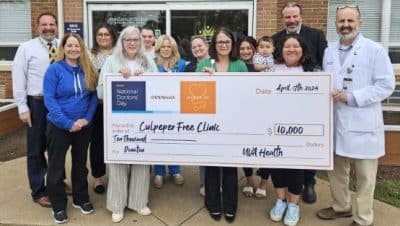
In 2016, more than 200,000 drivers ages 65 and older were injured in a traffic crash and more than 3,500 were killed. With seniors outliving their ability to drive safely by an average of seven to 10 years, families should not wait to talk about safety. AAA urges seniors to begin planning for “driving retirement” at the same time they begin planning for retirement from work.
“The right time to stop driving varies for everyone,” said Dr. David Yang, executive director of the AAA Foundation of Traffic Safety. “This research shows that older drivers can be hesitant to initiate conversations about their driving capabilities, so it is important that families encourage them to talk early and often about their future behind the wheel. With early discussion and proper planning, elderly drivers may extend their time on the road.”
The report is the latest research released in the AAA Foundation for Traffic Safety’s Longitudinal Research on Aging Drivers (LongROAD) project. Researchers found that only 17 percent of older drivers report ever speaking with a family member or physician about driving safety. The most commonly cited reasons for having the discussion include:
- Driving safety concerns (falling asleep while driving, trouble staying in lane): 65 percent
- Health issues: 22 percent
- Driving infraction or crash: 15 percent
- Planning for the future: 7 percent
AAA recommends that families start talking with older adults about safe driving early and avoid waiting until there are “red flags” like crashes, scrapes on the car (from bumping into garages, signs, etc.), new medical diagnoses, or worsening health conditions. It is helpful to begin discussions when an older driver starts planning for other life changes, like retirement from work or moving to a new home. When talking to an older driver, families should:
- Start early and talk often: Be positive, be supportive and focus on ways to help keep them safe when behind the wheel, including other forms of transportation available to older drivers.
- Avoid generalizations: Do not jump to conclusions about an older driver’s skills or abilities.
- Speak one-on-one: Keep the discussion between you and the older driver. Inviting the whole family to the conversation can create feelings of alienation or anger.
- Focus on the facts: Stick to information you know, like a medical condition or medication regimen that might make driving unsafe. Do not accuse an older driver of being unsafe or assume that driving should be stopped altogether.
- Plan Together: Allow the older driver to play an active role in developing the plan for their driving retirement.
“The best time to initiate a discussion with a loved one about staying mobile without a set of car keys is before you suspect there is a problem,” said Jake Nelson, AAA director of traffic safety advocacy and research. “Planning for personal mobility and independence should be done working shoulder to shoulder with the older driver. Talking sooner, rather than later, can help set mutual expectations and reduce safety issues or emotional reactions down the line.”
It is important that families have a plan to help keep the older driver on the road for as long as safely possible. Past research from the AAA Foundation for Traffic Safety found that older adults who have stopped driving are almost two times more likely to suffer from depression and nearly five times as likely to enter a long-term care facility as those who remain behind the wheel. Families can use the AAA Driver Planning Agreement as a guide to starting conversations about safety. The agreement allows families to plan together for future changes in driving abilities before they become a concern.
“Seniors who have a conversation with loved ones and use the resources available to them, may even find that they can drive a bit longer than they expected. Even slight changes that can help to improve visibility and other issues,” added Martha Mitchell Meade, Manager of Public and Government Relations AAA Mid-Atlantic.
For more information on AAA resources for older drivers, such as RoadWise online/classroom courses or other programs that help seniors better “fit” with their vehicles, visit www.SeniorDriving.AAA.
About LongROAD: Recognizing that lifestyle changes, along with innovative technologies and medical advancements will have a significant impact on the driving experiences of the baby boomer generation, the AAA Foundation for Traffic Safety has launched a ground-breaking, multi-year research program to more fully understand the driving patterns and trends of older drivers in the United States. The AAA LongROAD (Longitudinal Research on Aging Drivers) study is one of the largest and most comprehensive senior driver databases available on senior drivers incorporating 2,990 participants being followed for five years. It will support in-depth studies of senior driving and mobility to better understand risks and develop effective countermeasures.
About AAA Foundation for Traffic Safety: Established in 1947 by AAA, the AAA Foundation for Traffic Safety is a not-for-profit, publicly funded, 501(c)(3) charitable research and educational organization. The AAA Foundation’s mission is to prevent traffic deaths and injuries by conducting research into their causes and by educating the public about strategies to prevent crashes and reduce injuries when they do occur. This research is used to develop educational materials for drivers, pedestrians, bicyclists and other road users. Visit www.AAAFoundation.org.
About AAA: As North America’s largest motoring and leisure travel organization, AAA provides more than 57 million members with travel, insurance, financial and automotive-related services. Since its founding in 1902, the not-for-profit, fully tax-paying AAA has been a leader and advocate for the safety and security of all travelers. Motorists can map a route, identify gas prices, find discounts, book a hotel and access AAA roadside assistance with the AAA Mobile app for iPhone, iPad and Android. Learn more at AAA.com/mobile. Find more information on AAA clubs at AAA.com.










